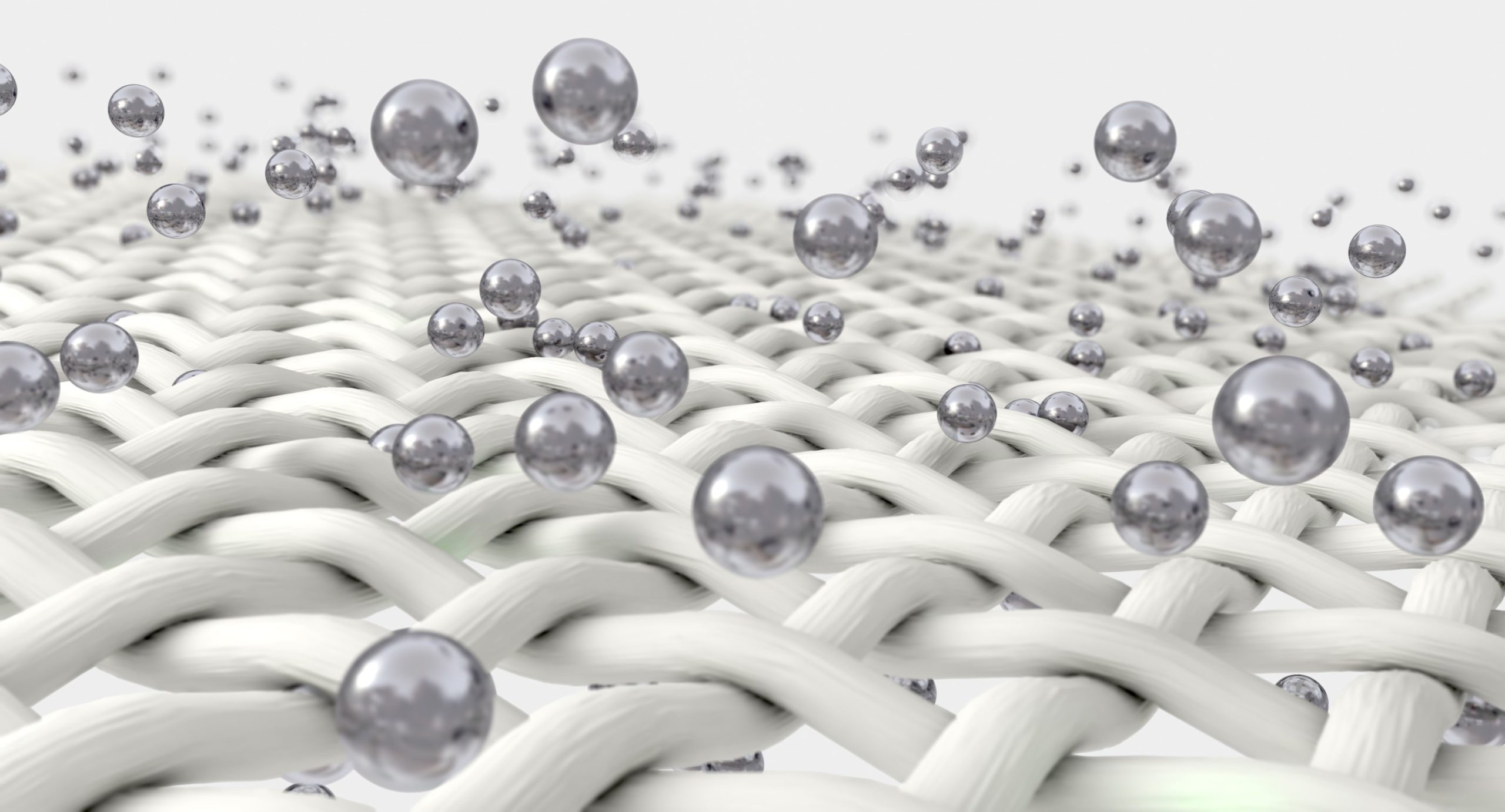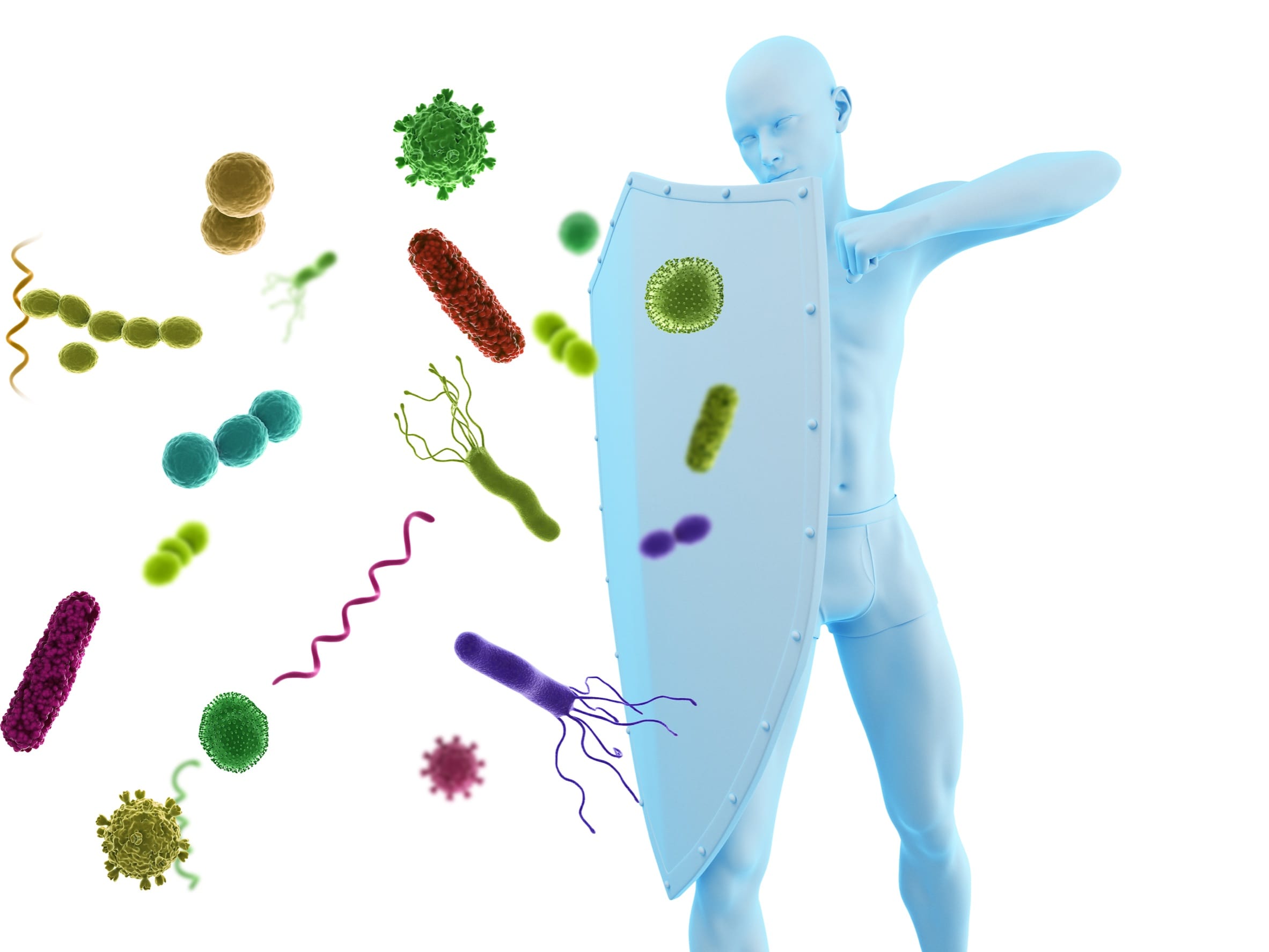How Shielding Works
To protect against potentially harmful effects from electromagnetic fields (EMF) exposure, high performance EMF shielding textiles have become a hot topic. The key to shielding centers around the implementation of conductive (metallic) fibers or particles within textiles to block EMFs. Nurture Guard™ offers personal shielding products that are exclusively made from silver-infused fabrics which provide the most effective EMF shielding on the market.
The rapid expanse of wireless technology and high-speed communications has resulted in an enormous influx of manufactured EMFs in the environment. Adverse health risks have been linked to manufactured EMFs forcing many people to consider ways of reducing exposure. Scientists assert wearing personal protective shielding and expanding distance from EMF sources are the main two ways to reduce adverse effects from EMF exposure. Real-world scenarios do not always allow for expanding distance from EMF sources especially for those who use technology for work purposes. This is where personal protective shielding comes into play.
Personal protective shielding is usually clothing, garments, or screen enclosures using materials that constitute a faraday cage. Such products need to be made of electroconductive textile materials often comprised of metallic nanomaterials. Pure metals are not practical for textiles whereas metallic nanomaterials can be uniformly dispersed and integrated on the surface of traditional materials. This method of conductive textile application has been scientifically proven to be effective at shielding EMF exposure to areas of the body that are covered by such materials.
References:
Atwa, Y., Maheshwari, N., & Goldthorpe, I. A. (2015). Silver nanowire coated threads for electrically conductive textiles. Journal of Materials Chemistry C, 3(16), 3908-3912.
Kurczewska, A., Stefko, A., & Byczkowska-Lipińska, L. (2012). Tests of materials shielding electromagnetic field of low and medium frequencies dedicated for screens or protective clothing. Stainless steel, 237(11), 0-09.
Li, H., Li, L., & Liu, J. (2015, June). Application of nano material for shielding power-frequency electromagnetic field. In IOP Conference Series: Materials Science and Engineering (Vol. 87, No. 1, p. 012013). IOP Publishing.
Liu, J., Lin, S., Huang, K., Jia, C., Wang, Q., Li, Z., ... & Wu, H. (2020). A large-area AgNW-modified textile with high-performance electromagnetic interference shielding. NPJ Flexible Electronics, 4(1), 1-7.
Maity, S., Singha, K., Debnath, P., & Singha, M. (2013). Textiles in electromagnetic radiation protection. Journal of Safety Engineering, 2(2), 11-19.
Zong, J. Y., Zhou, X. J., Hu, Y. F., Yang, T. B., Yan, D. X., Lin, H., ... & Li, Z. M. (2021). A wearable multifunctional fabric with excellent electromagnetic interference shielding and passive radiation heating performance. Composites Part B: Engineering, 225, 109299.

Nurture Guard™ uses silver nanomaterials infused with other popular textile materials to provide the most effective lightweight shielding protection from electromagnetic fields (EMF). Silver is the highest electrically conductive element with physical properties that reflect and dissipate EMF waves away from the body.
EMF shielding is mostly based on EMF reflection by charge carriers (particles that carry an electric charge). Therefore, high electrical conductivity is required for shielding materials to work. Silver has the highest electrical conductivity of any element, making it the best for shielding EMFs. This is due to positive charge of silver ions which act as a barrier to the negatively charged EMFs. When EMF waves encounters a silver barrier it forces charges in the material to oscillate at the same frequency as the incoming EMF waves. This forced oscillating charge behaves as an antenna that repels and scatters EMF waves. In addition, some EMF waves are absorbed into the fabric layers where it undergoes internal reflections that transforms EMFs into thermal energy. When silver is worn as clothing or garments, it provides a barrier over your skin that acts as a faraday cage to shield harmful EMFs from manufactured technology such as cellphones, Bluetooth, and WIFI. While it is impractical to always cover the entire body with garments, silver shielding can be a particularly useful tool for sensitive areas like a pregnant abdomen or an infant’s bedding.
References:
Atwa, Y., Maheshwari, N., & Goldthorpe, I. A. (2015). Silver nanowire coated threads for electrically conductive textiles. Journal of Materials Chemistry C, 3(16), 3908-3912.
Badulescu, M., Anghel, A., Surdu-Bob, C. C., Badic, M., Morari, C., & Balan, I. (2015). Preliminary results on the electromagnetic shielding effectiveness of organic fabrics silver coated by high voltage anodic plasma. Optoelectronics and Advanced Materials-Rapid Communications, 9(9-10), 1230-1233.
Gashti, M. P., Ghehi, S. T., Arekhloo, S. V., Mirsmaeeli, A., & Kiumarsi, A. (2015). Electromagnetic shielding response of UV-induced polypyrrole/silver coated wool. Fibers and Polymers, 16(3), 585-592.
Kardarian, K., Busani, T., Osório, I., Domingos, H., Igreja, R., Franco, R., & Cortez, J. (2014). Sintering of nanoscale silver coated textiles, a new approach to attain conductive fabrics for electromagnetic shielding. Materials Chemistry and Physics, 147(3), 815-822.
Kurczewska, A., Stefko, A., & Byczkowska-Lipińska, L. (2012). Tests of materials shielding electromagnetic field of low and medium frequencies dedicated for screens or protective clothing. Stainless steel, 237(11), 0-09.
Li, H., Li, L., & Liu, J. (2015, June). Application of nano material for shielding power-frequency electromagnetic field. In IOP Conference Series: Materials Science and Engineering (Vol. 87, No. 1, p. 012013). IOP Publishing.
Liang, C., Gu, Z., Zhang, Y., Ma, Z., Qiu, H., & Gu, J. (2021). Structural design strategies of polymer matrix composites for electromagnetic interference shielding: a review. Nano-Micro Letters, 13(1), 1-29.
Liu, J., Lin, S., Huang, K., Jia, C., Wang, Q., Li, Z., ... & Wu, H. (2020). A large-area AgNW-modified textile with high-performance electromagnetic interference shielding. NPJ Flexible Electronics, 4(1), 1-7.
Maity, S., Singha, K., Debnath, P., & Singha, M. (2013). Textiles in electromagnetic radiation protection. Journal of Safety Engineering, 2(2), 11-19.
Zong, J. Y., Zhou, X. J., Hu, Y. F., Yang, T. B., Yan, D. X., Lin, H., ... & Li, Z. M. (2021). A wearable multifunctional fabric with excellent electromagnetic interference shielding and passive radiation heating performance. Composites Part B: Engineering, 225, 109299.

When silver is infused into conventional textile materials (cotton, wool, nylon, etc.) it extends the uniquely high conductivity of that metal which transforms the finished material into a super-fabric with many useful benefits.
- Shields EMF radiation up to 99%
- Anti-microbial to eliminate microscopic pests and odor
- Enhanced thermal regulation for comfort
- Makes fabric more flexible, durable, and soft
- Anti-static: prevents electrostatic shocks
Silver is a lustrous and dazzling metal that is usually thought of as jewelry, coins, or bullion, but silver is much more than that! When silver is infused with traditional fabric materials even in small amounts, it provides a flexible and durable fabric with electrical and thermal conductivity properties. Silver-infused fabrics have been embraced by the space, medical, and military industries due to their effectiveness, light weight, flexibility, comfortability, and versatility in a wide range of applications. Nowadays, it is being assimilated for everyday consumer products like clothing, towels, bedding, and so much more.
Silver has the highest electrical and thermal conductivity of any other metal on earth. The electrically conductive property of silver acts as shield against EMF radiation and reduces static shocks. The thermal conductivity of silver infused fabrics allows for temperature regulation for the skin. Moreover, silver-infused fabrics are great for hygiene by killing off microbial skin infections, inflammation, illnesses, and odor. In addition, silver is biocompatible with humans and other animals; meaning it is non-toxic to skin, tissue, and other organs.
References:
Atwa, Y., Maheshwari, N., & Goldthorpe, I. A. (2015). Silver nanowire coated threads for electrically conductive textiles. Journal of Materials Chemistry C, 3(16), 3908-3912.
El-Rafie, M. H., Mohamed, A. A., Shaheen, T. I., & Hebeish, A. (2010). Antimicrobial effect of silver nanoparticles produced by fungal process on cotton fabrics. Carbohydrate Polymers, 80(3), 779-782.
Ge, L., Li, Q., Wang, M., Ouyang, J., Li, X., & Xing, M. M. (2014). Nanosilver particles in medical applications: synthesis, performance, and toxicity. International journal of nanomedicine, 9, 2399.
Lan, X., Wang, Y., Peng, J., Si, Y., Ren, J., Ding, B., & Li, B. (2021). Designing heat transfer pathways for advanced thermoregulatory textiles. Materials Today Physics, 17, 100342.
Liang, C., Gu, Z., Zhang, Y., Ma, Z., Qiu, H., & Gu, J. (2021). Structural design strategies of polymer matrix composites for electromagnetic interference shielding: a review. Nano-Micro Letters, 13(1), 1-29.
Maity, S., Singha, K., Debnath, P., & Singha, M. (2013). Textiles in electromagnetic radiation protection. Journal of Safety Engineering, 2(2), 11-19.
Tania, I. S., Ali, M., & Azam, M. (2019). In-situ synthesis and characterization of silver nanoparticle decorated cotton knitted fabric for antibacterial activity and improved dyeing performance. SN Applied Sciences, 1(1), 1-9.
Zhang, X., Chao, X., Lou, L., Fan, J., Chen, Q., Li, B., ... & Shou, D. (2021). Personal thermal management by thermally conductive composites: A review. Composites Communications, 23, 100595.
Zong, J. Y., Zhou, X. J., Hu, Y. F., Yang, T. B., Yan, D. X., Lin, H., ... & Li, Z. M. (2021). A wearable multifunctional fabric with excellent electromagnetic interference shielding and passive radiation heating performance. Composites Part B: Engineering, 225, 109299.

Silver-infused fabrics are great for hygiene because they kill microscopic invaders which cause skin infections, inflammation, illnesses, and odor. Silver has natural anti-microbial properties that kill mold, fungi, bacteria, and other harmful microbes. Moreover, silver is biocompatible with humans and other animals meaning it is non-toxic to skin, tissue, and other organs.
Conventional fabrics like cotton and wool provide an ideal environment for microorganisms to grow that can cause malodor, product deterioration, allergic responses, and other related issues. To counter the undesirable drawbacks of conventional fabrics many innovative solutions have been introduced into modern textiles. For hundreds of years, silver is among the most used element that delivers anti-microbial and anti-inflammatory properties to other materials. Silver is widely used by the medical community for applications such as device coating, wound dressings, textiles, contraceptive devices, and more. Nowadays there is an emergence of silver-infused hygienic textiles for everyday consumers like clothing, towels, and bedding.
Although the antimicrobial ability of silver is not clearly understood there is a consensus among scientists that the phenomena is real and proven particularly useful. Silver is known to be effective against over 650 types of bacteria including bacterial strains that are resistant to antibiotics. Some researchers of silver-infused fabrics have reported its ability to interrupt chemical bonds in microbe cells in insignificant amounts. Many scientists assert the release of silver ions (positive charge) are responsible for interfering with electrons in certain biological molecules. That interaction disrupts vital processes in microbe cells by acting on the cell membrane and penetrate to disrupt their metabolism and DNA reproduction. Meaning that whenever microbes encounter silver, the cell structure is physically damaged and inhibited to grow and multiply.
References:
Deng, X., Yu Nikiforov, A., Coenye, T., Cools, P., Aziz, G., Morent, R., ... & Leys, C. (2015). Antimicrobial nano-silver non-woven polyethylene terephthalate fabric via an atmospheric pressure plasma deposition process. Scientific reports, 5(1), 1-10.
El-Rafie, M. H., Mohamed, A. A., Shaheen, T. I., & Hebeish, A. (2010). Antimicrobial effect of silver nanoparticles produced by fungal process on cotton fabrics. Carbohydrate Polymers, 80(3), 779-782.
El-Shishtawy, R. M., Asiri, A. M., Abdelwahed, N. A., & Al-Otaibi, M. M. (2011). In situ production of silver nanoparticle on cotton fabric and its antimicrobial evaluation. Cellulose, 18(1), 75-82.
Ge, L., Li, Q., Wang, M., Ouyang, J., Li, X., & Xing, M. M. (2014). Nanosilver particles in medical applications: synthesis, performance, and toxicity. International journal of nanomedicine, 9, 2399.
Ki, H. Y., Kim, J. H., Kwon, S. C., & Jeong, S. H. (2007). A study on multifunctional wool textiles treated with nano-sized silver. Journal of Materials Science, 42(19), 8020-8024.
Tania, I. S., Ali, M., & Azam, M. (2019). In-situ synthesis and characterization of silver nanoparticle decorated cotton knitted fabric for antibacterial activity and improved dyeing performance. SN Applied Sciences, 1(1), 1-9.

Silver-infused fabric transfers and dissipates body heat to enable body temperature homeostasis. The high thermal conductivity of silver allows for more efficient temperature regulation by allowing body heat to be distributed quickly and evenly which forms a balanced microclimate for the skin.
Silver textile manufacturers use proprietary methods comprised of complex fabrication techniques and fiber blends to achieve thermoregulatory capabilities in fabrics. Silver’s high thermal conductivity property is useful for heat transference where higher conductivity results in more cooling while the body is radiating excess heat. When silver is combined with a variety of other materials and designs, it balances body temperature which facilitates better sleep. Blankets made with silver are ideal to regulate heat exchange and conservation to better enable the circadian rhythm of body temperature.
Humans are accustomed to using blankets with insulating materials like animals use nests to promote warmth and trigger sleep onset. Studies show that internal (core) body temperature slightly lowers during sleep onset which coincides with increased circulating melatonin in natural conditions as part of the circadian rhythm processes. The core cooling process during sleep onset dissipates heat from inside of the body. The skin acts as an innate “heat radiator” that can expand and contract blood flow by dilating or constricting tiny blood vessels depending on the ambient temperature. Due to silver’s thermal conductivity, excess heat is transferred from the skin and is absorbed into pores of insulating fabric material to create an ambient microclimate temperature within the comfort zone.
References:
Dulceata, V. (2014). Thermoregulation–temperature homeostasis. Marathon, 6(2), 150-153.
Harding, E. C., Franks, N. P., & Wisden, W. (2019). The temperature dependence of sleep. Frontiers in neuroscience, 13, 336.
Kräuchi, K. (2002). How is the circadian rhythm of core body temperature regulated?. Clinical Autonomic Research, 12(3), 147-149.
Lan, X., Wang, Y., Peng, J., Si, Y., Ren, J., Ding, B., & Li, B. (2021). Designing heat transfer pathways for advanced thermoregulatory textiles. Materials Today Physics, 17, 100342.
Maity, S., Singha, K., Debnath, P., & Singha, M. (2013). Textiles in electromagnetic radiation protection. Journal of Safety Engineering, 2(2), 11-19.
Refinetti, R., & Menaker, M. (1992). The circadian rhythm of body temperature. Physiology & behavior, 51(3), 613-637.
Yousef, H., & VARCALLO, M. (2020). Physiology, thermal regulation. StatPearls.
Zhang, X., Chao, X., Lou, L., Fan, J., Chen, Q., Li, B., ... & Shou, D. (2021). Personal thermal management by thermally conductive composites: A review. Composites Communications, 23, 100595.

Health experts believe silver to be mostly non-toxic to human and animal tissues. Currently, there is no definite evidence that proves significant health risks from silver exposure. Clinical observations by experts report silver-coated textiles used to treat skin conditions posed no risk to patients including children and infants.
Low levels of silver ion and particle release from materials are expected with realistic use and washing of consumer products containing silver. The potential for silver to leak from materials arouses some concern about their overall safety. Silver is widely embraced by the healthcare system because the low risk of silver exposure is heavily outweighed by its effective antimicrobial and anti-inflammatory effects. Textile manufacturers using nano-silver applications have poured enormous amounts of resources into researching fabrication methods and supporting materials to prevent silver leakage during use thus ensuring the safety and durability of silver nanomaterial fabrics that are put on the market. Moreover, silver has proven to be the safest metallic nanomaterial, even when compared to alternatives like copper.
Scientists report a potential toxicity or allergy affect from silver nanomaterials but document that it is extremely rare. Both animal studies and human clinical reports have failed to show a toxic risk from silver nanomaterials to the central or peripheral nervous systems. Studies done on skin applications and clothing show no adverse effects to the number or composition of human skin microflora (good/normal bacteria) or the skin barrier of healthy people. Whenever silver gets absorbed into the body through the skin or other tissues, it mostly gets metabolized and expelled through natural waste excretion processes.
References:
Ge, L., Li, Q., Wang, M., Ouyang, J., Li, X., & Xing, M. M. (2014). Nanosilver particles in medical applications: synthesis, performance, and toxicity. International journal of nanomedicine, 9, 2399.
Hipler, U. C., & Elsner, P. (Eds.). (2006). Biofunctional textiles and the skin (Vol. 33). Karger Medical and Scientific Publishers.
Hoefer, D., & Hammer, T. R. (2011). Antimicrobial active clothes display no adverse effects on the ecological balance of the healthy human skin microflora. International Scholarly Research Notices, 2011.
Lansdown, A. B. G. (2007). Critical observations on the neurotoxicity of silver. Critical reviews in toxicology, 37(3), 237-250.
Pang, C., Hristozov, D., Zabeo, A., Pizzol, L., Tsang, M. P., Sayre, P., & Marcomini, A. (2017). Probabilistic approach for assessing infants' health risks due to ingestion of nanoscale silver released from consumer products. Environment international, 99, 199-207.
Quadros, M. E., Pierson IV, R., Tulve, N. S., Willis, R., Rogers, K., Thomas, T. A., & Marr, L. C. (2013). Release of silver from nanotechnology-based consumer products for children. Environmental science & technology, 47(15), 8894-8901.
Stebounova, L. V., Adamcakova-Dodd, A., Kim, J. S., Park, H., O'Shaughnessy, P. T., Grassian, V. H., & Thorne, P. S. (2011). Nanosilver induces minimal lung toxicity or inflammation in a subacute murine inhalation model. Particle and fibre toxicology, 8(1), 1-12.

Watch these videos on shielding EMF radiation!
Don’t Miss Out!
GET 10% OFF OF YOUR FIRST PURCHASE
Get the latest on Sales, Special Offers, New Releases and more

